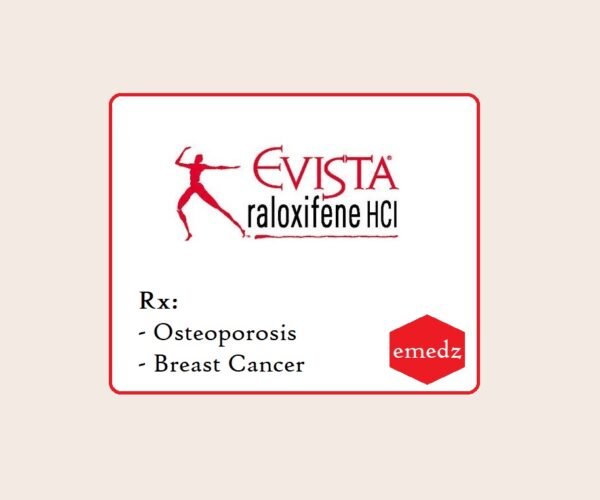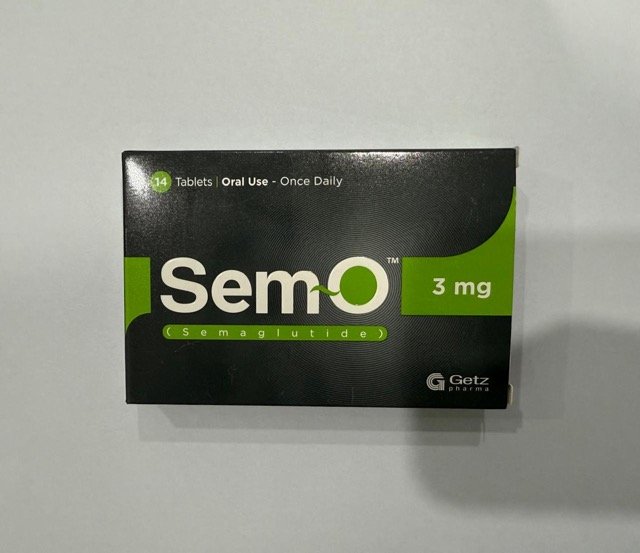Raloxifene (Evista) is a selective estrogen receptor modulator that is used for the treatment and prevention of postmenopausal osteoporosis. It is also used to reduce the risk of invasive breast cancer in postmenopausal women.
Raloxifene (Evista) Uses:
-
Osteoporosis:
- It is used to prevent and treat osteoporosis in postmenopausal women
-
Risk reduction for invasive breast cancer:
- It reduces the risk of invasive breast cancer in postmenopausal women with osteoporosis who are at high risk of invasive breast cancer.
- Limitations of use:
- It does not eliminate the risk of breast cancer
- Breast exam and mammogram before starting the raloxifene then according to current guideline recommendations
- It can not be used for the treatment of invasive breast cancer and it does not reduce the risk of recurrence
- It does not reduce the risk of noninvasive breast cancer
- The effect of raloxifene on the incidence of invasive breast cancer in women with inherited mutations BRCA1, BRCA2 are not known.
Other SERMs: Tamoxifen (Nolvadex)
Raloxifene (Evista) Dose in Adults
Raloxifene (Evista) Dose in the prevention of Osteoporosis in postmenopausal females:
- Oral: 60 mg once a day.
Note Supplemental calcium and vitamin D if dietary intake is inadequate.
Raloxifene (Evista) Dose as an alternate agent in the treatment of Osteoporosis in postmenopausal females:
- Oral: 60 mg once a day.
Note:
- There is no demonstrated efficacy in the prevention of hip and nonvertebral fracture, so, raloxifene should not be used as the initial preferred therapy in most patients.
- If the patient has a low bone mineral density in the spine but not the hip or in patients with a high risk of invasive breast cancer, raloxifene may be reasonable.
- The patient should receive supplemental calcium and vitamin D if dietary intake is inadequate.
Raloxifene (Evista) Dose in the treatment of Risk reduction for invasive breast cancer in postmenopausal females:
- Oral: 60 mg once a day.
-
Duration of therapy for breast cancer risk reduction:
- 5 years
- More than 5 years in women can be used with osteoporosis where breast cancer risk reduction is a secondary benefit
Use in Children:
Not indicated.
Preganancy Risk Category: X
- It is not recommended during pregnancy.
Use during breastfeeding:
- It is not known if it is present in breast milk.
- It shouldn't be used by females with reproductive potential.
Dose in Kidney Disease:
- CrCl ≤50 mL/minute:
- The manufacturer has not provided dose adjustment in labeling;
- Use cautiously.
Dose in Liver disease:
The manufacturer has not provided dose adjustment in labeling. Use cautiously in patients with liver disease.
Common Side Effects of Raloxifene:
-
Cardiovascular:
- Peripheral Edema
-
Endocrine & Metabolic:
- Hot Flash
-
Infection:
- Infection
-
Neuromuscular & Skeletal:
- Arthralgia
- Leg Cramps
- Muscle Spasm
-
Respiratory:
- Flu-Like Symptoms
Less Common Side Effects of Raloxifene (Evista):
-
Cardiovascular:
- Chest Pain
- Syncope
- Venous Thromboembolism
-
Central Nervous System:
- Insomnia
- Hypoesthesia
- Neuralgia
-
Dermatologic:
- Skin Rash
- Diaphoresis
-
Endocrine & Metabolic:
- Weight Gain
-
Gastrointestinal:
- Abdominal Pain
- Vomiting
- Gastrointestinal Disease
- Flatulence
- Gastroenteritis
-
Genitourinary:
- Vaginal Hemorrhage
- Mastalgia
- Leukorrhea
- Urinary Tract Abnormality
- Uterine Disease
- Endometrium Disease
-
Neuromuscular & Skeletal:
- Myalgia
- Tendon Disease
-
Respiratory:
- Bronchitis
- Sinusitis
- Pharyngitis
- Pneumonia
- Laryngitis
Contraindication to Raloxifene (Evista):
- Pre-existing or current venous embolism (including DVT and PE)
- Pregnancy
Warnings and precautions
-
Thromboembolic Events: [US Boxed Warning]
- Raloxifene can cause DVT or PE. If the patient has venous thromboembolism, it is contraindicated.
- Consider risk vs. benefit strategies if there is a possibility of thromboembolism.
- This could include heart failure, superficial thrombophlebitis or active malignancy.
- The risk of venous embolism is greater in the first four months after starting raloxifene.
-
History of breast cancer:
- There are no adequate studies on the effects of raloxifene on women who have had breast cancer in the past.
-
Cardiovascular disease: [US-Boxed Warning]
- Postmenopausal women who have coronary heart disease or are at greater risk for a major coronary event, such as raloxifene users, are at higher risk of stroke.
- If you have to make a decision, weigh the risks and benefits.
- TIA, Atrial fibrillation and hypertension are all risk factors for stroke.
-
Hepatic impairment
- Avoid use in patients with hepatic impairment. Safety and efficacy of the product have not been established.
-
Hypertriglyceridemia:
- There is a higher chance of hypertriglyceridemia if the patient has a history that includes markedly increased triglycerides (>5.6 mg/L or 500 mg/dL) due to the use of oral estrogen/progestins.
- These patients should be monitored for triglycerides.
-
Renal impairment
- Moderate to severe renal impairments should be avoided. Safety and efficacy of this product have not been established.
-
Uterine bleeding:
- Before or during treatment, investigate the causes of unexplained uterine bleeding.
Raloxifene: Drug Interaction
|
Bile Acid Sequestrants |
May decrease the absorption of Raloxifene. |
|
Levothyroxine |
Raloxifene may decrease the absorption of Levothyroxine. |
|
Ospemifene |
Selective Estrogen Receptor Modulators may enhance the adverse/toxic effect of Ospemifene. Ospemifene may also enhance adverse/toxic effects of other Selective Estrogen Receptor Modulators. Selective Estrogen Receptor Modulators may diminish the therapeutic effect of Ospemifene. Ospemifene may also diminish the therapeutic effects of other Selective Estrogen Receptor Modulators. |
Monitoring parameters:
- Lipid profile (in women at risk for hypertriglyceridemia)
- Mammogram and breast examination before starting raloxifene and during therapy
- Osteoporosis: Bone mineral density (BMD): 1 - 2 years after starting therapy and every 1 - 2 years thereafter
- Annual measurements of height and weight
- Serum calcium and 25(OH)D;
- Biochemical markers of bone turnover can also be considered for monitoring
How to administer Raloxifene (Evista)?
- It can be taken with or without food at any time of day.
Mechanism of action of Raloxifene (Evista):
- Raloxifene [SERM] is a selective estrogen receptor modator. It can be used to both agonist and antagonist activities.
- It selectively binds to and activates estrogenic pathway in certain tissues, and antagonizes those pathways in others.
- Raloxifene is an estrogen agonist in bone, which can be beneficial in osteoporosis.
- It also has estrogen antagonist activity that blocks some estrogen effects in breast and uterine tissue.
- It reduces bone resorption and increases bone mineral density.
Absorption:
- It is rapidly absorbed.
- About 60% of the drug gets absorbed.
Protein binding:
- 95% to albumin and α-glycoprotein;
- does not bind to sex hormone-binding globulin
Metabolism:
- It is mainly metabolized in the liver and undergoes an extensive first-pass metabolism;
- It is metabolized to glucuronide conjugates
Bioavailability:
- about 2%
Half-life elimination:
- 27.7 hours after a single dose
- 32.5 hours after multiple doses
Excretion:
- Feces (primarily)
- urine (<0.2% as unchanged drug; <6% as glucuronide conjugates)
International Brand Names of Raloxifene:
- Evista
- ACT Raloxifene
- APO-Raloxifene
- Evista
- PMS-Raloxifene
- TEVA-Raloxifene
- Alofix
- Bonmax
- Celvista
- Debista
- Eilen
- Eva
- Evifyne
- Evista
- Larfen
- Loxar
- Optruma
- Opturma
- Ostiral
- Oxilar
- Prelox
- Ralogen
- Ralosis
- Ralox
- Raloxiqueen
- Raxeto
- Razxip
- Rolage
- Sedovesta
- Vexiphen
- Zotralox
Raloxifene Brand Names in Pakistan:
Raloxifene HCl Tablets 60 mg in Pakistan |
|
| Denser | Valor Pharmaceuticals |
| Evista | Eli Lilly Pakistan (Pvt) Ltd. |
| Hoxif | Lexicon Pharmaceuticals (Pvt) Ltd. |
| Loxiam | Amarant Pharmaceuticals (Pvt) |
| Osteonil | Standpharm Pakistan (Pvt) Ltd. |
| Osteox | Macter International (Pvt) Ltd. |
| Ralox | Pulse Pharmaceuticals |
| Raloxi | Hansel Pharmacueutical Pvt (Ltd) |
| Relofin | Consolidated Chemical Laboratories (Pvt) Ltd. |
| Revera | Tagma Pharma (Pvt) Ltd. |



.jpeg)



